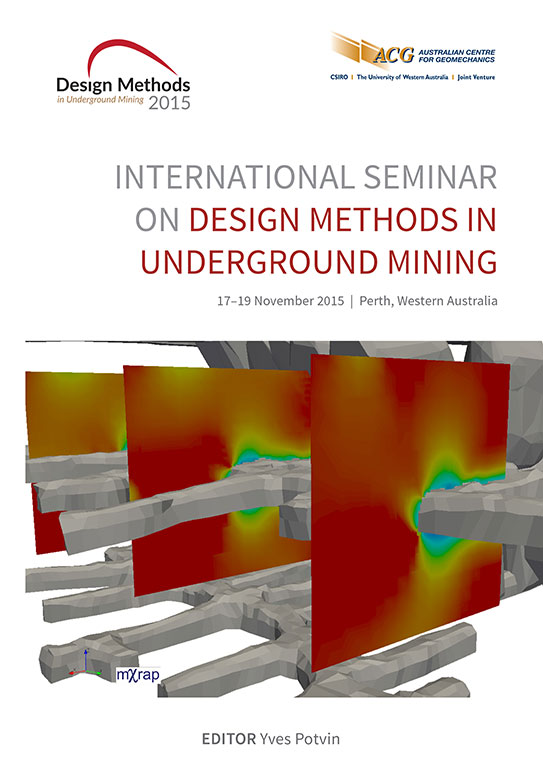Development of an integrated platform for stability analysis and design in sublevel stoping mines — MineRoc®

|
Authors: Vallejos, JA; Miranda, O; Gary, C; Delonca, A |
DOI https://doi.org/10.36487/ACG_rep/1511_29_Vallejos
Cite As:
Vallejos, JA, Miranda, O, Gary, C & Delonca, A 2015, 'Development of an integrated platform for stability analysis and design in sublevel stoping mines — MineRoc®', in Y Potvin (ed.), Design Methods 2015: Proceedings of the International Seminar on Design Methods in Underground Mining, Australian Centre for Geomechanics, Perth, pp. 477-488, https://doi.org/10.36487/ACG_rep/1511_29_Vallejos
Abstract:
In sublevel stoping mining operations, the amount of rock overbreak from the walls plays a fundamental role in recovery and dilution control. In the case of massive orebodies, the amount of overbreak may produce interferences in the productive process and excessive wearing of drawpoints. In the case of narrow veins, the amount of overbreak may produce excessive dilution. All of these variables define the production plan of the mine. At present, a large amount of information is collected during operations. This information includes the grades and extracted tonnage, fragmentation, lithology, design of stopes and main infrastructure, geotechnical information, overbreak progress, seismicity, numerical modelling, and many other mine variables. To improve the reliability of the stability analysis design of stopes and the production plan, it is necessary to integrate the mine data in one platform. In this paper, the logic of MineRoc® is presented as an integrated technological platform for stability analysis in sublevel stoping mines. MineRoc includes an acquisition platform for mine data and geotechnical information, a geomechanical design module for stopes, and a back-analysis platform for calibrating mine design tools. The application and benefits of MineRoc are illustrated for sublevel open stope Chilean mining operations. Unified databases and updated design stability tools are developed, presented, and discussed. The platform can be used in the mine design and planning processes and is useful for reducing uncertainty in the mine design of sublevel stoping operations.
References:
Arjang, B & Herget, G 1997, ‘In situ ground stresses in the Canadian hardrock mines: an update’, International Journal of Rock Mechanics and Mining Sciences, vol. 34, no. 3-4, pp. 15.e1-15.e16.
Barton, N, Lien, R & Lunde, J 1974, ‘Engineering classification of rock masses for design of tunnel support’, Rock Mechanics and Rock Engineering, vol. 6, no. 4, pp. 189-236.
Bewick, R & Kaiser, PK 2009, ‘Numerical assessment of factor B in Mathews’ method for open stope design’, in M Diederichs & G Grasselli (eds), Proceedings of the Third Canada-US Rock Mechanics Symposium and the 20th Canadian Rock Mechanics Symposium (RockEng09), pp. 89-90.
Bieniawski, ZT 1976, ‘Rock mass classification in rock engineering’, in ZT Bieniawski (ed.), Exploration for rock engineering: proceedings of the symposium on exploration for rock engineering, A.A. Balkema, Lisse, pp. 97-106.
Castro, C 2014, ‘Numerical modeling of dilution by over-break in underground mining by sub-level stoping’ Masters thesis, University of Chile.
Clark, LM & Pakalnis, RC 1997, ‘An empirical design approach for estimating unplanned dilution from open stope hangingwalls and footwalls’, Proceedings of the CIM 99th Annual General Meeting, Canadian Institute of Mining, Metallurgy and Petroleum, Westmount, QC.
Deere, DU, Hendron, AJ, Patton, FD & Cording, EJ 1967, ‘Design of surface and near-surface construction in rock’, Proceedings of the 8th US Symposium on Rock Mechanics (USRMS), American Rock Mechanics Association, Minneapolis, MN, pp. 237-302.
Galarce, T 2014, ‘In-situ stress model Chile and its incidence in the design of underground mining’ Bachelor’s thesis, University of Chile.
Hoek, E & Brown, ET 1997, ‘Practical estimates of rock mass strength’, International Journal of Rock Mechanics and Mining Sciences, vol. 8, pp. 1165-1186.
Mathews, KE, Hoek, E, Wyllie, DC & Stewart, S 1981, Prediction of stable excavation spans for mining at depths below 1,000 metres in hard rock / Golder Associates, CANMET Library & Documentation Services Division, Vancouver.
Mawdesley, CA 2002, ‘Predicting rock mass cavability in block caving mines’, PhD thesis, University of Queensland.
Mitri, HS, Hughes, R & Zhang, Y 2011, ‘New rock stress factor for the stability graph method’, International Journal of Rock Mechanics and Mining Sciences, vol. 48, pp. 141-145.
Nickson, SD 1992, ‘Cable support guidelines for underground hard rock mine operations’, Master of Science thesis, University of British Columbia.
Potvin, Y 1988, ‘Empirical open stope design in Canada’ PhD thesis, University of British Columbia.
Stewart, SBV & Forsyth, WW 1995, ‘The Mathews method for open stope design’, Bulletin of the Canadian Institute of Mining and Metallurgy, vol. 88, no. 992, pp. 45-53.
Trueman, R, Mikula, P, Mawdesley, C & Harries, N 2000, ‘Experience in Australia with the application of the Mathews’ method for open stope design’, Bulletin of the Canadian Institute of Mining and Metallurgy, vol. 93, pp. 162-167.
© Copyright 2025, Australian Centre for Geomechanics (ACG), The University of Western Australia. All rights reserved.
View copyright/legal information
Please direct any queries or error reports to repository-acg@uwa.edu.au
View copyright/legal information
Please direct any queries or error reports to repository-acg@uwa.edu.au